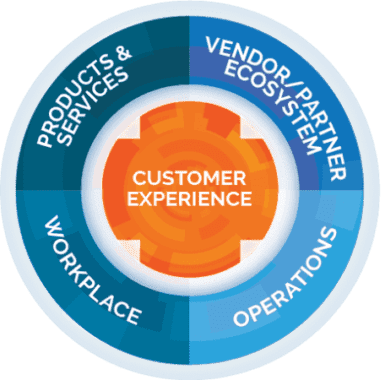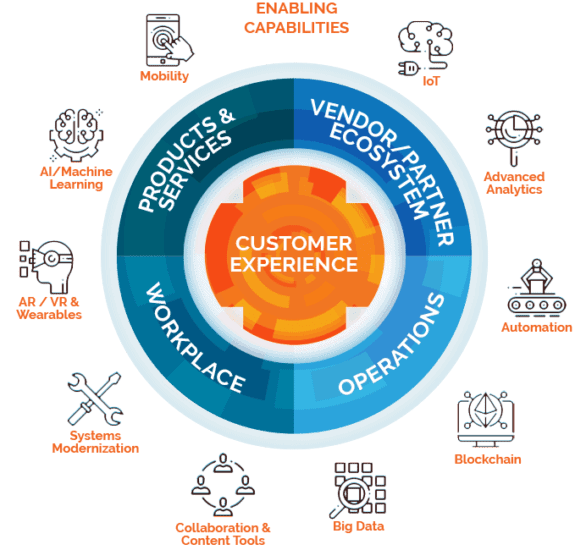Enhancing Customer Experience Through
Digital Transformation
Successful companies today have one thing in common – they transformed themselves to deliver “exceptional experience” to their customers increasing share of wallet. In this article, we’ll explore why and how enhancing customer experience through digital transformation is vital to succeed.
What is Customer Experience?
The digital revolution in the past decade has transformed the way customers interact with brands and purchase products. New entrants upended existing markets, and legacy brands that did not adapt were forced to shrink or die.
The term “customer experience”, or CX for short, has a unique connotation for many individuals. As a consumer, many variables influence the way we perceive an organization’s effort to provide optimal customer experience by tailoring their products and services based on age, race, likes and dislikes, personal preferences, etc.
In today’s market, digital transformation has become a status quo to keep up with, bringing forth the urgency to adopt new technologies and keep up with consumer demands and preferences. Businesses striving to enhance the quality of interactions with their customers’ are turning to digital tools and technologies to consistently improve themselves on this front. However, in this journey, it’s crucial to ask yourself, “why is this truly important?”
“It is not the strongest of the species that survives, nor the most intelligent. It is the one that is most adaptable to change.”
–Leon C. Megginson: Previous Professor of Management and Marketing

The Business Transformation
Today’s consumers are widely celebrated for their newly empowered behaviors. Through use of various avenues of technology (such as mobile apps), consumers provide businesses with the ability to harness insightful data, such as behavioral statistics and preferences. Further, despite the hectic nature of this demand, businesses are encouraging more engagement on this front, continually urging consumers to provide as much information as they can.
Businesses must learn to transform and position themselves in such a way that they’re able to deliver exceptional customer experience to these consumers, tailored to their unique demands. In this way, organizations adopting technology to enhance their customer experience capabilities are truly undergoing a business transformation. Influential decision makers must rally each level of the organization around this ideal if they wish to succeed. Here are some key drivers influencing a business transformation:

Smartbridge Transformation Framework
The Digital Transformation
Technology not only impacts the products or services being produced, but also the way consumers prefer to use them. Consumer expectations are extremely high in the current market, and organizations are striving to digitize themselves without becoming faceless. This expectation holds true in every aspect of the engagement process. For example, most customers want a frictionless experience while browsing for a particular product, direct access to a customer service representative in the event of a question, and real-time tracking once an order is placed. Altogether, consumers have grown to expect best-in-class user experience from online, mobile, and even off-line interactions.
Organizations that deliver on these expectations will succeed, while others who simply cannot keep up will fail. Customers have gotten used to Amazon-like experience and they expect the same from other brands. This is where businesses must transform their processes to deliver the ‘exceptional customer experience’ promise by establishing and executing digital transformation. Speed and agility is critical to stay ahead of the competition. You need to establish the digital skills and capabilities to move your company to this state quickly. Ramp up your internal staff, and partner with technology specialists like Smartbridge to assess and transform your existing practices into a well-oiled digitized machine. Some areas that support this effort are the following:

Smartbridge Transformation Framework
Impact on Supply and Demand
Digitization can be disruptive to industries when the natures of supply and demand are changed, depending on if said changes are modest or extreme. Spotting opportunities for disruption, both internally and externally will serve as a pinnacle point for providing enhanced customer experience through digital transformation.
Modest Change
Extreme Change
Assess, Adapt, and Implement
Undergoing both a business and digital transformation is crucial to thriving and surviving in today’s economy. Organizations must first assess themselves and their goals for creating exceptional customer experience, and transform digitally to put those goals into practice.
Through adopting best-of-breed technologies, businesses can optimize their efforts both internally and externally through enhancing consumer user experience.
Looking for more on Digital Innovation?
Explore more insights and expertise at smartbridge.com/digitalinnovation
There’s more to explore at Smartbridge.com!
Sign up to be notified when we publish articles, news, videos and more!
Other ways to
follow us:


